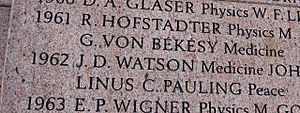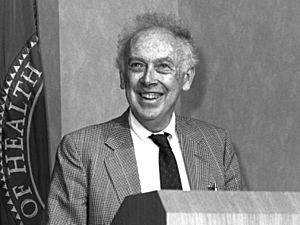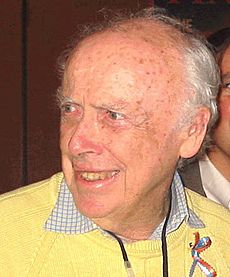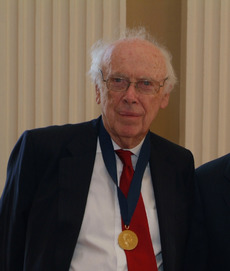James Watson facts for kids
Quick facts for kids
James Watson
|
|
|---|---|
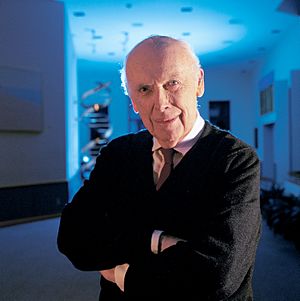
Watson c. 2011
|
|
| Born |
James Dewey Watson
April 6, 1928 Chicago, Illinois, U.S.
|
| Died | November 6, 2025 (aged 97) East Northport, New York, U.S.
|
| Education | |
| Known for | |
| Spouse(s) |
Elizabeth Lewis
(m. 1968) |
| Children | 2 |
| Awards |
|
| Scientific career | |
| Fields | Genetics |
| Institutions | |
| Thesis | The Biological Properties of X-Ray Inactivated Bacteriophage (1951) |
| Doctoral advisor | Salvador Luria |
| Doctoral students |
|
| Other notable students |
|
| Signature | |
James Dewey Watson (April 6, 1928 – November 6, 2025) was an American molecular biologist, geneticist, and zoologist. In 1953, he worked with Francis Crick to publish an important paper in the journal Nature. This paper suggested the double helix structure of the DNA molecule.
In 1962, Watson, Crick, and Maurice Wilkins received the Nobel Prize in Physiology or Medicine. They were honored for their discoveries about the structure of nucleic acids. This work was very important for understanding how information is passed on in living things.
Watson earned his first degree from the University of Chicago in 1947. He then completed his PhD at Indiana University Bloomington in 1950. After studying in Copenhagen, Watson joined the University of Cambridge's Cavendish Laboratory in England. There, he met Francis Crick, who would become his key partner in research.
From 1956 to 1976, Watson taught at Harvard University. He helped advance research in molecular biology during this time. Starting in 1968, Watson became the director of Cold Spring Harbor Laboratory (CSHL). He greatly increased its funding and research efforts. He also focused on studying cancer, making CSHL a top center for molecular biology. He served as president for 10 years starting in 1994. Later, he became chancellor until he resigned in 2007. Some of his honorary titles were revoked in 2019 due to certain comments he made.
Watson wrote many science books. These include the textbook Molecular Biology of the Gene (1965) and his popular book The Double Helix (1968). From 1988 to 1992, Watson worked with the National Institutes of Health. He helped start the Human Genome Project, which mapped the entire human genetic code by 2003.
Contents
Early Life and Education Journey
James Dewey Watson was born in Chicago on April 6, 1928. His father was a businessman, and his mother had Scottish and Irish roots. Watson grew up in Chicago and went to public schools.
He loved watching birds, a hobby he shared with his father. He even thought about studying ornithology (the study of birds). Watson also appeared on Quiz Kids, a radio show for smart young people. At age 15, he received a scholarship to the University of Chicago.
In 1946, Watson read a book called What Is Life? by Erwin Schrödinger. This book inspired him to switch from studying birds to genetics. The next year, he earned his Bachelor of Science degree in zoology. In 1947, Watson moved to Indiana University for graduate school. He was drawn there by the work of Nobel Prize winner Hermann Joseph Muller. Watson earned his PhD from Indiana University Bloomington in 1950. His advisor was Salvador Luria.
Scientific Career and Discoveries
Early Research with Phages
Watson became interested in molecular biology through the work of Salvador Luria. Luria later won a Nobel Prize for his studies on genetic mutations. Watson joined a group of scientists called the "Phage Group". They studied bacteriophages, which are viruses that infect bacteria.
This group believed they were close to understanding the physical nature of the gene. In 1949, many scientists thought genes were proteins. However, Watson knew about the Avery–MacLeod–McCarty experiment, which suggested that DNA was the genetic material. Watson's early research involved using X-rays to study bacterial viruses.
In 1950, Watson went to Copenhagen University for postdoctoral research. He wanted to explore the structure of DNA. While there, he saw Maurice Wilkins present X-ray diffraction data for DNA. This convinced Watson that DNA had a clear molecular structure that could be figured out.
Unraveling the Double Helix Structure

In March 1953, Watson and Crick figured out the double helix structure of DNA. Their discovery relied heavily on experimental data from King's College London. This data was mainly collected by Rosalind Franklin and her student Raymond Gosling. Franklin's high-quality X-ray images of DNA were crucial. Her work showed that the sugar-phosphate backbones were on the outside of the molecule. She also identified that the two DNA strands were antiparallel.
Lawrence Bragg, the director of the Cavendish Laboratory where Watson and Crick worked, first announced the discovery. Watson and Crick then published their paper, "Molecular Structure of Nucleic Acids: A Structure for Deoxyribose Nucleic Acid", in Nature on April 25, 1953.
Many scientists were impressed by the new DNA model. Sydney Brenner, Dorothy Hodgkin, and others saw the model in April 1953. The discovery was a turning point in science. It changed how we understand life and started the modern era of biology.
Watson, Crick, and Wilkins received the Nobel Prize in Physiology or Medicine in 1962. Rosalind Franklin had passed away in 1958, so she was not eligible for the award. However, her vital contributions to the discovery are widely recognized. Watson and Crick acknowledged in a 1954 article that their structure would have been "most unlikely, if not impossible" without Franklin's data.
Teaching and Research at Harvard
In 1956, Watson joined the biology department at Harvard University. His research there focused on RNA and its role in carrying genetic information. He remained a Harvard faculty member until 1976.
During his time at Harvard, Watson spoke out on important issues. He joined a protest against the Vietnam War. He also spoke against the spread of nuclear weapons, arguing about the dangers of radioactive waste.
Watson wrote several important textbooks. His first, The Molecular Biology of the Gene, was published in 1965. He also helped coordinate Molecular Biology of the Cell. His book Recombinant DNA explained how genetic engineering was revealing new information about living things.
Writing The Double Helix
In 1968, Watson wrote The Double Helix. This book tells the story of how the structure of DNA was discovered. It also describes the people involved and the challenges they faced. The book was very popular and is considered one of the 100 best nonfiction books.
Leading Cold Spring Harbor Laboratory
In 1968, Watson became the director of the Cold Spring Harbor Laboratory. He and his family made their home there. Watson led the laboratory for about 35 years, first as director and then as president and chancellor.
Under Watson's leadership, CSHL grew significantly. It became a world-renowned institution for research and education. The lab's mission is to explore molecular biology and genetics. This helps advance our understanding and treatment of diseases like cancer and neurological conditions. Scientists at CSHL made major contributions to understanding the genetic causes of cancer.
The Human Genome Project
In 1990, Watson was chosen to lead the Human Genome Project at the National Institutes of Health. This project aimed to map the entire human genetic code. He held this position until 1992.
Watson believed that the human genome should belong to everyone in the world. He was against the idea of patenting gene sequences. He left the project after disagreements about this issue. In 2007, Watson became one of the first people to have his full genetic code sequenced and published online. He hoped this would encourage the development of personalized medicine. This is where genetic information is used to prevent and treat diseases in a unique way for each person.
Later Life and Contributions
In 2014, Watson published a paper in The Lancet. He suggested new ideas about how biological oxidants might be involved in diseases like diabetes, dementia, and cancer.
Also in 2014, Watson sold his Nobel Prize medal at an auction. He used the money to support scientific research and conservation efforts. He was the first living Nobel winner to sell his medal. The medal was later returned to him by the buyer, Alisher Usmanov.
Mentoring Future Scientists
Watson guided many students who went on to become important scientists. Some of his doctoral students include Mario Capecchi, Bob Horvitz, Peter B. Moore, and Joan Steitz. He also mentored postdoctoral researchers like Ewan Birney, Ronald W. Davis, and Phillip Allen Sharp.
Personal Life and Family
Watson married Elizabeth Lewis in 1968. They had two sons, Rufus Robert Watson (born 1970) and Duncan James Watson (born 1972). Watson sometimes spoke about his son Rufus, who has schizophrenia. He hoped to encourage more research into how genetics contributes to mental illness.
Passing Away
James Watson passed away in East Northport, New York, on November 6, 2025, at the age of 97. News organizations like The New York Times and the BBC recognized him as one of the most important scientists of the 20th century. They noted that his work helped explain how DNA copies itself and carries genetic information, leading to huge advances in molecular biology.
Awards and Honors Received
Watson received many awards for his scientific achievements:
- Albert Lasker Award for Basic Medical Research, 1960
- Benjamin Franklin Medal for Distinguished Achievement in the Sciences (2001)
- Copley Medal of the Royal Society, 1993
- CSHL Double Helix Medal Honoree, 2008
- Eli Lilly Award in Biological Chemistry, 1959
- EMBO Membership in 1985
- Gairdner Foundation International Award, 2002
- Honorary Member of Royal Irish Academy, 2005
- Honorary Fellow, the Hastings Center, an independent bioethics research institution
- Honorary Knight Commander of the Order of the British Empire (KBE), 2002
- Irish America Hall of Fame, inducted March 2011
- John J. Carty Award in molecular biology from the National Academy of Sciences
- Liberty Medal, 2000
- National Medal of Science, 1997
- Nobel Prize in Physiology or Medicine, 1962
- Othmer Gold Medal (2005)
- Presidential Medal of Freedom, 1977
- Golden Plate Award of the American Academy of Achievement, 1986
Honorary Degrees from Universities
- DSc, University of Chicago, US, 1961
- DSc, Indiana University, US, 1963
- LLD, University of Notre Dame, US, 1965
- DSc, Long Island University (CW Post), US, 1970
- DSc, Adelphi University, US, 1972
- DSc, Brandeis University, US, 1973
- DSc, Albert Einstein College of Medicine, US, 1974
- DSc, Hofstra University, US, 1976
- DSc, Harvard University, US, 1978
- DSc, Rockefeller University, US, 1980
- DSc, Clarkson College of Technology, US, 1981
- DSc, Rutgers University, US, 1988
- DSc, Bard College, US, 1991
- DSc, University of Stellenbosch, South Africa, 1993
- DSc, Fairfield University, US, 1993
- DSc, University of Cambridge, United Kingdom, 1993
- DrHC, Charles University in Prague, Czech Republic, 1998
- ScD, University of Dublin, Ireland, 2001
Professional and Honorary Memberships
- American Academy of Arts and Sciences
- American Association for Cancer Research
- American Philosophical Society
- American Society of Biological Chemists
- Athenaeum Club, London, member
- Cambridge University, Honorary Fellow, Clare College, Cambridge
- Cold Spring Harbor Laboratory, Chancellor Emeritus; Honorary Trustee; Oliver R. Grace Professor Emeritus (some titles revoked in 2019)
- European Molecular Biology Organization, member since 1985
- National Academy of Sciences
- Oxford University, Newton-Abraham Visiting Professor
- Royal Danish Academy of Sciences and Letters
- Royal Society, Foreign Member of the Royal Society (ForMemRS) since 1981
- Russian Academy of Sciences
Images for kids
-
Watson signing autographs after a speech at Cold Spring Harbor Laboratory on April 30, 2007
See also
 In Spanish: James Dewey Watson para niños
In Spanish: James Dewey Watson para niños
- Behavioral genetics
- History of molecular biology
- History of RNA biology
- Life Story – a 1987 BBC film about the discovery of DNA structure
- List of RNA biologists
- Predictive medicine
- Whole genome sequencing


